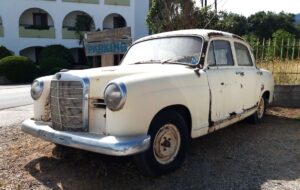
Mabel’s family, the Hall-Dares of Newtownbarry, were in the first wave of Co. Wexford gentry to adopt the horseless carriage – although in all probability not a Merc, the first of which rolled off the production lines as late as 1926 apparently.
This vehicle, illustrated above, is now resignedly, like an old grey, seeing out its retirement in a public carpark in Plakias, south-western Crete, a hundred metres or so from the shores of the Libyan Sea. As a marque of respect, the researchers of the Bent Archive, recently in the area (May 2022), resorted to Mabel Bent’s Chronicle of April 1885 to confirm that the nearest the Bents got to Plakias (a huddle of fishermen’s huts at the time) was from some way out to sea, heading west for Kythera on the steamer Roumeli from Karpathos.
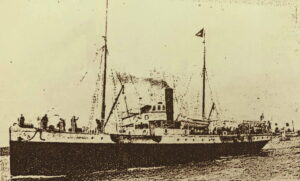
In fact, in their twenty years of inseparable travelling, Theodore and Mabel only landed together once on Crete, then in the hands of the Turks, storm-sheltering at Kaloi Limenes/Kali Limenes, further to the east of Plakias, after their protracted investigations in the Dodecanese (early months, 1885). The haven, of course, has always aided those in peril on the sea, as it did Saint Paul, as the legend has it. Once the weather cleared, the Roumeli steamed on west, rounding Crete and Antikythera, before reaching Kythera town.
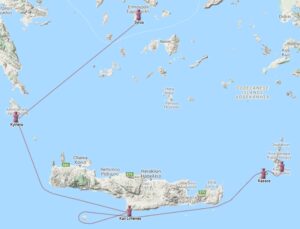
It is unclear why Crete, this major island, never attracted Theodore’s spade, but it probably had something to do with his notoriety; the era of freelancing excavators was coming to an end in Greece and Turkey, and Bent was soon to make an enemy of the implacable Turkish administrator of antiquities, Osman Hamdi Bey. The site of Knossos had been discovered in 1878 (the year after the Bents’ wedding) by Minos Kalokairinos, although it was not until 1900 that Arthur Evans began to extensively clear it. (For a glimpse of Cretan archaeological machinations in 1885, see, e.g., Frothingham 1888. Theodore did very well to steer clear, and, from 1886 eastwards to the Turkish coast. Within a few years, even here became too difficult for the Bents to explore at will, and they were soon off to Africa and Arabia, where they could more freely investigate.)
But, for the moment, back to Crete. Here, then, are the relevant extracts from Mabel’s notebook of their stay of a few hours on the island, at Kaloi Limenes, some fifty years before the great John Pendlebury ran across the hills above the site, as oblivious of his fate as Theodore was of his:
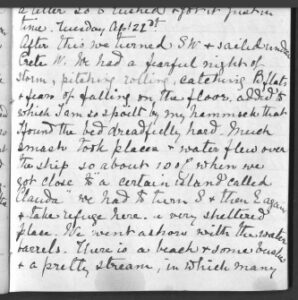
“Tuesday April 22nd [actually 21st, 1885]. After this we turned S.W. and sailed under Crete. We had a fearful night of storm, pitching, rolling, catching ‘B flats’ [fleas/bedbugs] and fears of falling on the floor. Added to which I am so spoiled by my hammock that I found the bed dreadfully hard. Much splashing took place and water flew over the ship, so about 10 o’clock, when we got close to ‘a certain island called Clauda’ [Acts 27:16. The Saint shelters here while travelling, as a prisoner, by ship to Rome. The ancient town of Lasea was nearby], we had to turn S. then E. again and take refuge here – a very sheltered place. We went ashore with the water barrels. There is a beach and some bushes and a pretty stream in which many clothes were washed by those who subsequently landed, and all the hands and faces washed, so no doubt we came back a cleaner party than we went…
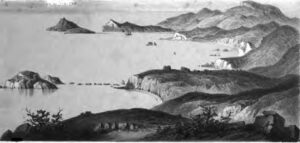
“The annoyance at being turned back was quite overborne by the interest of coming to Kalé Liminas, and it was a great satisfaction to think that St. Paul must have drunk and washed in that very stream, and being stormstayed too was rather nice. The city of Lasea, which was nigh unto the Fair Havens, has disappeared but the place is the same…
“Wednesday, April [22nd, 1885]. We started at 8 in the evening and after a good deal of tossing got into calmer regions, but still were ‘under Crete’ in the morning [passing the huts of Plakias to starboard]. We had a lovely day. About 10 we passed Cerigotto, or as they call it Ante Kythera, and about 12 reached Kythera, or Cerigo, and found ourselves in a very pretty little double bay with a rocky promontory in the middle and a sandy shore.”
A postscript is that the widowed Mabel did return to Crete over the winter of 1901/02, but we don’t know what she did or where she stayed there. “Mrs. Theodore Bent, who spent the winter in Crete, is now at her house in Great Cumberland Place, London.” (Lady of the House, Thursday, 15 May 1902)
[The extracts are from The Travel Chronicles of Mabel Bent, Vol 1, pages 120-122 (Oxford, Archaeopress)]. Leave a comment or contact us about this article
Leave a comment or contact us about this article